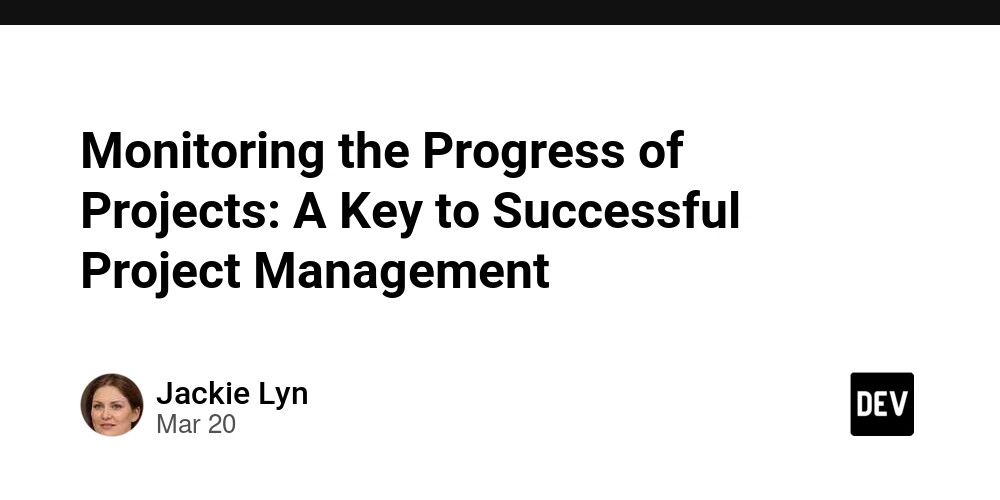Monitoring the Progress of Projects: A Key to Successful Project Management
In the fast-paced world of project management, the ability to monitor and track the progress of projects is crucial to ensuring that they are completed on time, within budget, and according to the specified standards. Monitoring the progress project managers stay on top of any issues or obstacles, make informed decisions, and adjust strategies to maintain the momentum. In this article, we will explore the importance of monitoring project progress, the key metrics to track, and best practices for effectively managing this aspect of project execution. Why Monitoring Project Progress is Crucial Monitoring the progress of a project involves assessing how the project is advancing towards its goals, ensuring that all tasks are on track, and identifying any deviations or risks that might hinder its success. Here’s why it’s so important: Ensures Timely Delivery: Regular monitoring helps identify delays early, allowing project managers to make adjustments to the schedule or allocate more resources to critical tasks. It ensures the project stays on track to meet deadlines. Maintains Budget Control: By tracking the financial progress of a project, it’s easier to avoid overspending. Regular monitoring helps project managers keep the budget in check and make necessary financial adjustments if needed. Identifies Risks Early: Monitoring project progress allows project managers to spot potential risks early on, from resource shortages to external factors that might impede progress. This enables them to devise mitigation strategies before these risks become significant problems. Enhances Stakeholder Communication: Regular updates on project progress keep stakeholders informed and engaged. By providing transparent and accurate reports, project managers can build trust with clients, team members, and other stakeholders. Improves Decision-Making: Data from progress tracking allows for informed decision-making. If a project is veering off course, monitoring progress provides the insights necessary to determine what changes need to be made, whether it's reallocating resources or adjusting the scope. Key Metrics to Monitor To effectively track project progress, it’s important to focus on the right metrics. These metrics vary depending on the nature of the project, but generally, the following are essential: Schedule Performance (Time): This is perhaps the most fundamental metric, tracking whether tasks are being completed on time. Using tools like Gantt charts or critical path method (CPM) can help visualize this progress. Cost Performance (Budget): Monitoring costs ensures that the project is being completed within its allocated budget. Earned Value Management (EVM) is a popular technique for tracking cost and schedule performance against the project plan. Scope: Monitoring whether the project scope is being adhered to is vital. Any changes or scope creep can derail a project, and it’s important to identify these changes early. Quality: Ensuring the deliverables meet quality standards is a key part of project success. Monitoring quality involves regular inspections, audits, and reviews of the deliverables to ensure they align with project goals. Resource Utilization: Assessing the use of resources, including human resources, equipment, and materials, ensures that the project is not under-resourced or over-extended. Risk Management: Tracking risks involves identifying new risks, evaluating their potential impact, and monitoring the progress of mitigation actions. Best Practices for Monitoring Project Progress To effectively monitor project progress, project managers should implement best practices that allow them to stay ahead of issues and ensure smooth execution. Here are some strategies: Use Project Management Tools: Modern project management software like Trello, Asana, Jira, or Microsoft Project allows project managers to visualize tasks, track deadlines, assign responsibilities, and manage resources in real-time. These tools provide automatic updates and reporting features to simplify progress tracking. Set Clear Milestones: Break the project down into smaller, measurable milestones that are easier to track. This will give you a clear sense of whether the project is on schedule and where bottlenecks might be occurring. Conduct Regular Check-Ins: Schedule regular team meetings or check-ins with stakeholders to discuss the progress of tasks, identify any challenges, and make necessary adjustments. These meetings can also be an opportunity to celebrate achievements and boost team morale. Monitor Key Performance Indicators (KPIs): Establish specific KPIs for the project and regularly assess them to gauge overall performance. These KPIs should be aligned with project goals and objectives. Track Changes and Scope Creep: Any changes to the project scope should be carefully monitored and assessed. Ensure that any scope changes are documented, approved, and accounted for in the project sch

In the fast-paced world of project management, the ability to monitor and track the progress of projects is crucial to ensuring that they are completed on time, within budget, and according to the specified standards. Monitoring the progress project managers stay on top of any issues or obstacles, make informed decisions, and adjust strategies to maintain the momentum. In this article, we will explore the importance of monitoring project progress, the key metrics to track, and best practices for effectively managing this aspect of project execution.
Why Monitoring Project Progress is Crucial
Monitoring the progress of a project involves assessing how the project is advancing towards its goals, ensuring that all tasks are on track, and identifying any deviations or risks that might hinder its success. Here’s why it’s so important:
Ensures Timely Delivery: Regular monitoring helps identify delays early, allowing project managers to make adjustments to the schedule or allocate more resources to critical tasks. It ensures the project stays on track to meet deadlines.
Maintains Budget Control: By tracking the financial progress of a project, it’s easier to avoid overspending. Regular monitoring helps project managers keep the budget in check and make necessary financial adjustments if needed.
Identifies Risks Early: Monitoring project progress allows project managers to spot potential risks early on, from resource shortages to external factors that might impede progress. This enables them to devise mitigation strategies before these risks become significant problems.
Enhances Stakeholder Communication: Regular updates on project progress keep stakeholders informed and engaged. By providing transparent and accurate reports, project managers can build trust with clients, team members, and other stakeholders.
Improves Decision-Making: Data from progress tracking allows for informed decision-making. If a project is veering off course, monitoring progress provides the insights necessary to determine what changes need to be made, whether it's reallocating resources or adjusting the scope.
Key Metrics to Monitor
To effectively track project progress, it’s important to focus on the right metrics. These metrics vary depending on the nature of the project, but generally, the following are essential:
Schedule Performance (Time): This is perhaps the most fundamental metric, tracking whether tasks are being completed on time. Using tools like Gantt charts or critical path method (CPM) can help visualize this progress.
Cost Performance (Budget): Monitoring costs ensures that the project is being completed within its allocated budget. Earned Value Management (EVM) is a popular technique for tracking cost and schedule performance against the project plan.
Scope: Monitoring whether the project scope is being adhered to is vital. Any changes or scope creep can derail a project, and it’s important to identify these changes early.
Quality: Ensuring the deliverables meet quality standards is a key part of project success. Monitoring quality involves regular inspections, audits, and reviews of the deliverables to ensure they align with project goals.
Resource Utilization: Assessing the use of resources, including human resources, equipment, and materials, ensures that the project is not under-resourced or over-extended.
Risk Management: Tracking risks involves identifying new risks, evaluating their potential impact, and monitoring the progress of mitigation actions.
Best Practices for Monitoring Project Progress
To effectively monitor project progress, project managers should implement best practices that allow them to stay ahead of issues and ensure smooth execution. Here are some strategies:
Use Project Management Tools: Modern project management software like Trello, Asana, Jira, or Microsoft Project allows project managers to visualize tasks, track deadlines, assign responsibilities, and manage resources in real-time. These tools provide automatic updates and reporting features to simplify progress tracking.
Set Clear Milestones: Break the project down into smaller, measurable milestones that are easier to track. This will give you a clear sense of whether the project is on schedule and where bottlenecks might be occurring.
Conduct Regular Check-Ins: Schedule regular team meetings or check-ins with stakeholders to discuss the progress of tasks, identify any challenges, and make necessary adjustments. These meetings can also be an opportunity to celebrate achievements and boost team morale.
Monitor Key Performance Indicators (KPIs): Establish specific KPIs for the project and regularly assess them to gauge overall performance. These KPIs should be aligned with project goals and objectives.
Track Changes and Scope Creep: Any changes to the project scope should be carefully monitored and assessed. Ensure that any scope changes are documented, approved, and accounted for in the project schedule and budget.
Analyze Trends and Forecasting: By analyzing historical data and trends, project managers can forecast future challenges and outcomes. This predictive approach helps anticipate delays and other issues before they impact the project significantly.
Encourage Open Communication: Foster an environment where team members feel comfortable reporting issues or challenges. Open lines of communication allow for early identification of problems and quicker resolution.
Document Progress: Keep a comprehensive record of the progress made throughout the project. This includes task completion, risk mitigation efforts, budget expenditures, and milestones. These records are valuable for post-project analysis and future projects.
Conclusion
Monitoring the progress of a project is essential for ensuring that it is completed successfully. By closely tracking key metrics like time, cost, quality, and scope, project managers can identify and address issues before they escalate. Adopting the right tools, setting clear milestones, and maintaining open communication are some of the most effective ways to keep projects on track. Ultimately, effective progress monitoring not only leads to successful project outcomes but also enhances team performance, stakeholder satisfaction, and organizational growth.










































































































































































![[The AI Show Episode 142]: ChatGPT’s New Image Generator, Studio Ghibli Craze and Backlash, Gemini 2.5, OpenAI Academy, 4o Updates, Vibe Marketing & xAI Acquires X](https://www.marketingaiinstitute.com/hubfs/ep%20142%20cover.png)



























































































































![[FREE EBOOKS] The Kubernetes Bible, The Ultimate Linux Shell Scripting Guide & Four More Best Selling Titles](https://www.javacodegeeks.com/wp-content/uploads/2012/12/jcg-logo.jpg)



![From drop-out to software architect with Jason Lengstorf [Podcast #167]](https://cdn.hashnode.com/res/hashnode/image/upload/v1743796461357/f3d19cd7-e6f5-4d7c-8bfc-eb974bc8da68.png?#)






































































































.png?#)




.jpg?#)
































_Christophe_Coat_Alamy.jpg?#)







































































































![Rapidus in Talks With Apple as It Accelerates Toward 2nm Chip Production [Report]](https://www.iclarified.com/images/news/96937/96937/96937-640.jpg)









































































































































